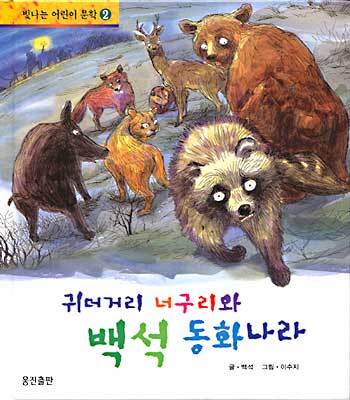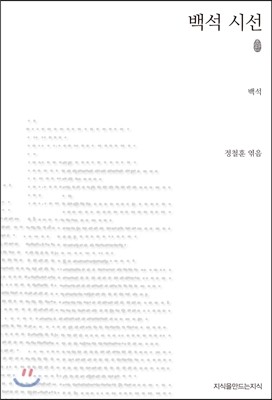Baek Seok (1912 -1996) was a Korean poet.
Life
Baek Seok was born Baek Kihaeng in Chongju, North Pyongan Province. He made his literary debut in 1930, winning the Chosun Ilbo New Writer's Contest with his short story "Geu mowa adeul" (그 모와 아들 That Mother and Son). He started his journalistic career at the Chosun Ilbo in 1934 and published his first poem, "Jeongjuseong" (정주성 Chongju Fortress), in the same paper the following year. In January 1935 he published a 100-copy limited edition of Saseum (사슴 Deer), containing 33 poems. Until 1948, he published about 60 more poems, but is not believed to have produced another poetry book.
In 1937 Baek resigned from the Chosun Ilbo and moved to Hamhung to teach English and focus on his poetry. "Nawa natashawa huin dangnagui" (나와 나타샤와 흰 당나귀 Me, Natasha and a White Donkey) was written during this stay. Baek rejoined the Chosun Ilbo briefly in 1939, publishing Seohaengsicho (서행시초 Traveling West), written while traveling Pyongan and Hamgyong.
After the liberation Baek returned to his hometown, where he focused on children's literature and Russian translation, but was criticized for his literary views. In 1958 he was banished to a farming collective in Samsu, where he lived out his life as a shepard and farmer. In South Korea, Baek's works were long banned due to his North Korean associations. However, since 1988, with the first publication of his works since the Korean War, he has been widely re-evaluated by scholars and critics. In 2007 Baek was listed by the Korean Poets' Association among the ten most important modern Korean poets.
Writing
As a foundational poet of the early modernist movement, Baek Seok utilized not only Pyongan dialect and archaic words but also language from other provinces. Like Kim Sowol, Baek Seok used the flavorful dialect of his region, though his early poems, especially, dealt with the local countryside and its human inhabitants rather than the more subjective realms that Kim Sowol explored. Like Im Hwa, though, Baek’s work shows a shift from a sense of locatedness and almost tactile connection to those who people the poems, to the depression and anomie that seem characteristic of much of the literary work of the 1930s.[1]
One of the outstanding features of Baek's work is its folk character, recounting the customs and manners of common people from the pre-modern era and expression an earnest devotion to Korean folk style in the voice of the modern citizenry. This method allows us to gain insight into the connection of people to their ethnic customs and cultural heritage, as with "Yeounan goljok" (여우난 곬족 Family of Fox Valley) or "Goya" (고야 Ancient Night), and other poems that convey a sense of communal unity to the reader.[2]
Baek drew influences from the surrounds of nature, writing pastoral poetry that tapped into the memories of the people in a natural setting that emphasized the objects surrounding Koreans in their daily lives. The universals of food and farm and mountain and village and beasts, not mystic but common and not common but comfortable, all found familiarity in his poems’ framework. Employing a borrowed landscape technique put into practice by traditional landscape artists to avoid the use of unnecessary artifice, he brought man closer to nature epitomizing the Korean ideal of intimacy and harmony with nature.[2]
[1] McCann, David R. The Columbia Anthology of Modern Korean Poetry. New York, Columbia University Press, 2004. p.84
[2] Baek, Seok, et al. Baek Seok: Poems of the North : A View into the Lives and Culture of the People of North Korea. Roseville, Hungry Dictator Press, 2019. p.7, p.16
Publicó su primer poema "La fortaleza Jeongjuseong" el 31 de agosto de 1935 en el Chosun Ilbo. El 20 de enero del siguiente año publicó de forma personal una recopilación de poemas titulada El ciervo (Sasŭm). Aunque su libro de poesía era único, solo se imprimieron 100 copias. El ciervo contenía 33 poemas basados en la estructura de variaciones Goldberg de J. S. Bach, la cual acababa de publicarse dos años antes en París grabada por Wanda Landowska. La mayoría de los poemas de El ciervo eran nuevos, pero siete de ellos ya se habían publicado en revistas o periódicos. Hasta 1948 publicó unos 60 poemas, pero se cree que no hizo ninguna otra recopilación de poesía.
En la República de Corea estuvo estrictamente prohibida la publicación de su obra por un tiempo, pues estaba considerado un poeta norcoreano y comunista. Sin embargo, desde 1987, con la primera publicación de sus poemas y ensayos después de la Guerra de Corea, su obra ha vuelto a ser analizada por académicos y críticos. Actualmente se considera que abrió un nuevo aspecto del modernismo socialista coreano junto con un grupo de escritores literarios.
En Corea del Sur se creyó durante mucho tiempo que había fallecido en una granja colectiva en 1963. Sin embargo, hace poco se supo que vivió hasta 1995.2
Le premier poème publié par Baek Sok fut La forteresse Jeongju (Jeongju seong), publié le 31 août 1935 dans le journal Chosun Ilbo. L'année suivante, le 20 janvier, il publie un recueil de poèmes intitulée Cerf (Saseum). Malgré l'originalité et l'authenticité du recueil de poésies, seulement 100 copies furent publiées. Cerf contient 33 poèmes basés sur la composition des Variations Goldberg de J. S. Bach, pour lequel un enregistrement réalisé par Wanda Landowska venait d'être publié deux ans auparavant à Paris. La plupart des poèmes de Cerf furent publiés pour la première fois, mais sept d'entre eux avaient déjà été publiés dans d'autres revues auparavant. Jusqu'en 1948, il publia 60 autres œuvres, mais on estime qu'il n'a pas publié d'autres recueils de poésies.
En Corée, la publication de son œuvre fut formellement interdite dans la mesure où il était considéré comme un poète communiste nord-coréen. Pourtant, en 1987, avec les premières publications de son œuvre en Corée du Sud, il gagna considérablement en popularité auprès du grand public et de la critique. Il est désormais considéré comme un précurseur du modernisme en Corée2.
本名は夔行である。白石の詩の世界は、当時のモダニズムの影響をうけながらも、郷土的な叙情の世界を方言で表す特徴を持っている。日帝植民地時代に苦しむ民衆の哀歓を描いていた。「私とナターシャと白いロバ」にはモダニズムのイメージを用い、 「エビガラスズメが来る夕方」や 「カズラン峠」などには一般の読者もわからない方言を用いるなど、民俗的な世界を表している。
また、「尼僧」では、山谷の金鉱でトウモロコシを売っていた女が尼僧になる悲しい生涯を書いた。1945年以降は翻訳をしたり、詩を書いたりした。
백석(1912~1996)은 대한민국의 시인이다.
생애
백석은 1912년 평안북도 정주에서 태어났다. 1924년 오산소학교를 졸업하고 오산학교에 입학했으며, 6년 선배인 김소월을 동경하며 시인의 꿈을 키웠다. 1929년 오산학교를 졸업한 후, 1930년에 《조선일보》 신춘문예에 단편소설 〈그 모(母)와 아들〉이 당선되었다. 이후 일본으로 건너가 아오야마학원 전문부 영어사범학교를 다녔다. 1934년에 졸업하여 귀국한 후 해방이 될 때까지 조선일보사, 영생여자고등보통학교, 여성사, 왕문사 등에 근무하였다.
1935년 잡지 《조광》의 창간에 참여하였고, 같은 해 《조선일보》에 시 〈정주성〉을 발표하면서 본격적인 작품 활동을 시작했다. 1936년 그간 자신이 쓴 시 33편을 모아 시집 《사슴》을 한정판으로 간행했다. 1940년에 만주로 건너가 잠시 만주국 국무원 직원으로 일했으나 창씨개명의 압박으로 그만두었다. 해방 후 고향인 정주로 돌아왔으며 1937년 문학예술총동맹 외국문학 분과의원이 되었다. 이 시기에 남한 잡지에 마지막으로 〈남신의주 유동 박시봉방〉(1948)을 발표하였다.
이후 외국문학 번역에 힘쓰는 한편 꾸준히 시를 발표하다 아동문학과 관련하여 자아비판을 하게 되었다. 1959년 국영협동조합 축산반에서 양 치는 일을 맡아 일하며 시 창작을 하였다. 그러나 1962년 북한 문화계에 복고주의에 대한 비판이 일어나면서 창작활동을 하지 못하게 되었다. 1996년 세상을 떠났다.
작품세계
백석의 유일한 시집 《사슴》은 1936년 자가본(自家本)으로 처음 출간되었으며, 총 33편의 시가 수록되어 있다. 1부 ‘얼럭소 새끼의 영각’에는 〈여우난 골족(族)〉을 비롯하여 6편, 2부 ‘돌절구의 물’에 9편, 3부 ‘노루’에 〈여승〉 등 9편, 4부 ‘국수당 너머’에 〈정주성〉 등을 비롯해 9편의 작품이 나뉘어 수록되었다. 이 작품은 시인의 고향인 평안북도의 사투리를 활용한 설화체를 통해 향토적이고 민속적인 세계를 담아냈다.
대표작 중 하나인 〈노루〉는 2행으로 이루어진 작품이다. 새로운 삶에 대한 희망, 노동 뒤의 충만함이 평화로운 전경과 어우러지지만, 이러한 과거의 행복은 현재와 단절되었고 그것이 2행이라는 형식에 감추어져 있다. 시인의 또 다른 대표작인 〈여우난 골족〉은 유년인 화자의 눈을 통해 포착된 평안북도 지방의 정겹고 토속적인 민속의 세계를 그렸다. 이 세계는 가족공동체의 삶이 온전히 구현된 공간으로, 어린 시절 명절에 친척들을 만나 음식 냄새를 맡으며 아이들이 북적하게 놀던 기억을 표현했다.
백석의 시들은 월북 문인의 해금 조치가 취해진 1988년 이래로 학계와 일반 독자들의 꾸준한 관심을 받아왔으며, 2007년 현역 시인들을 대상으로 한 설문에서 최고의 한국 현대시집으로 꼽히기도 했다.
주요 작품
1) 전집
《백석시전집》, 창작사, 1987.
《백석전집》, 새문사, 1990
《백석 전집》, 미래사, 1991.
《백석시전집》, 학영사, 1995.
《백석전집》, 실천문학사, 1997.(증보개정판, 2003/2011)
《백석시전집》, 창비, 2010.
《백석문학전집》, 서정시학, 2012.(개정판, 2017)
《백석시전집: 탄생 100주년 기념판》, 흰당나귀, 2012.
《백석 시전집》, 지식을만드는지식, 2013.
2) 시집
《사슴》, 선광인쇄주식회사, 1936.
《사슴: 백석 탄신 일백주년 기념, 백석 시집》, 서정시학, 2012.
《(원본)백석 시집》, 깊은샘, 2017.
《(정본)백석 시집》, 문학동네, 2020.





